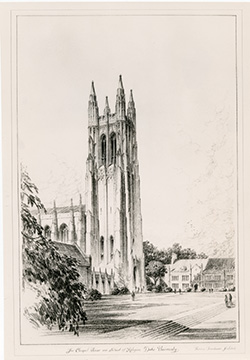Julian Abele's Quiet Contributions to Duke's Campus

In the mid-1920s, at the height of the Gilded Age, a Philadelphia architecture firm was quietly drafting ambitious plans for a new university campus in Durham.
The chief designer of the new campus in the segregated South was an African-American architect named Julian Francis Abele.
Few knew of Abele’s contribution to Duke’s design at the time, and his role remained little-known until the 1980s. Yet Abele designed many of Duke’s most iconic buildings and played a central role in defining Duke’s overall architectural style.
Abele was an unusual man for his time, a path-breaking, turn-of the-century African-American architect in a field where African-Americans were -- and still are -- underrepresented.
The youngest of eight children, he grew up in a prominent African-American family in Philadelphia and was educated in the city’s Quaker schools. He went on to study at the University of Pennsylvania, becoming the first African-American to graduate from the university’s Graduate School of Fine Arts.
Upon graduation, Philadelphia architect Horace Trumbauer promptly recruited Abele to join his firm and sponsored Abele’s further studies at the Ecole des Beaux Arts in Paris. In Paris, Abele deepened his appreciation for classical influences in architecture and for the Beaux Arts style.
He would spend the rest of his career at the Trumbauer firm.
Trumbauer and Abele were a bit of an odd couple. Trumbauer had dropped out of school at age 16 and learned the profession of architecture through apprenticeship. The public face of the firm, he recruited much of the business.
Abele, by contrast, was erudite and reserved. Outside of work, he devoted himself to artistic pursuits including woodcarving, music and needlepoint.
“Julian Abele was a modest, quiet man,” said Duke University Archivist Valerie Gillispie. “He was a talented man, an artist who worked mostly behind the scenes.”
Trumbauer and Abele worked closely together guiding the design and construction of Duke’s West Campus until Trumbauer’s death in 1938. The precise division of labor between the two men during that period is unknown; the firm’s practice was to sign architectural drawings with the Trumbauer firm name rather than crediting individual architects.
One comment by Abele provides a clue to the pair’s close working relationship, though. Describing Philadelphia’s Free Library, Abele once said, “The lines are all Mr. Trumbauer’s, but the shadows are all mine.”
Scholars and archivists believe Abele, as the firm’s chief designer, provided the guiding hand and design vision for Duke’s West Campus, including Duke Chapel and the West Campus quads, as well as for many East Campus buildings, including Baldwin Auditorium.
“We know he was chief designer of the campus,” Gillispie said. “We see elements of design that reflect his time in Europe.”
The Trumbauer firm was also active in Philadelphia and the northeast. Abele is credited with leading the design for Harvard University’s Widener Memorial Library, the Philadelphia Museum of Art, the Free Library of Philadelphia and a number of Gilded Age mansions in Newport, Rhode Island and New York City, including the Fifth Avenue mansion of James B. Duke.
After Trumbauer’s death, Abele became a principal in the Traumbauer firm. He continued to work closely with Duke, designing Cameron Indoor Stadium, among other buildings.
Abele was belatedly admitted into the American Institute of Architects in 1942 and was among the slim ranks of prominent African-American architects at his death in 1950.
Some details in the Abele story disappeared when the firm closed in 1968 and its records were destroyed, making some questions hard to answer definitively. For instance, it has been suggested that Abele never set foot on the campus he designed. However, several of Abele’s contemporaries recalled that he did visit Duke.
Gillispie interviewed Abele’s son, Julian Abele Jr., several years ago and asked about his father’s role at Duke.
“He said his father was very proud of the Duke campus,” Gillispie said.
Meanwhile, the passion for architecture has lived on in the Abele family tree: Julian Abele Jr. and several other descendants went on to become architects, including Abele’s great-grand nephew Peter Cook, a Washington, D.C. architect who served on the design team for the Smithsonian’s new National Museum of African American History and Culture, slated to open in September on the National Mall.
Further reading:
http://www.smithsonianmag.com/ist/?next=/history-archaeology/shadow.html
http://muse.jhu.edu/journals/southern_cultures/v015/15.1.king.pdf
http://library.duke.edu/rubenstein/uarchives/history/articles/abele
http://www.archives.upenn.edu/people/1800s/abele_julian_fra_wm.html